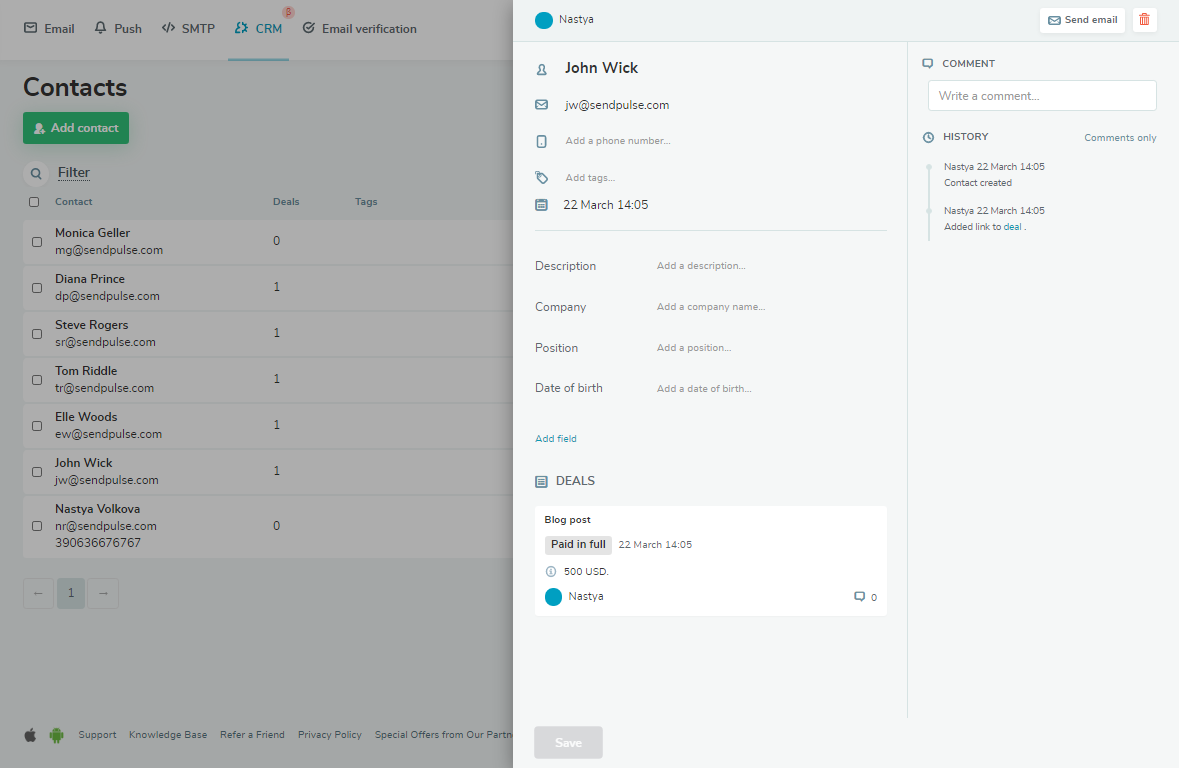Lead management is the process of tracking and recording a company’s touchpoints with its leads. Analyzing your customer acquisition strategy and lead qualification and nurturing will help you create a lead funnel that converts.
In this article, you’ll discover why lead management is vital and get some tips on how to build an effective lead management process for your business.
Why is lead management important?
Every startup needs to think about the quality of its lead generation strategy when its prospects drop off. Marketers often blame different communication channels, targeting the wrong audience, or insufficient warm-up. When they make the appropriate changes to the strategy and see little or even no result, lead management comes into play.
Lead management allows business owners to have a 360-view of their customers’ position in the sales funnel. Using a CRM system for managing leads provides companies with a holistic picture of their sales funnel effectiveness.
Lead management helps marketers cope with the following tasks:
- reveal top-performing marketing channels that are worth the investment;
- single out the most effective lead acquisition instruments;
- identify the most qualified leads and sort them later based on their demographics, buyer journey stage, level of interest, and engagement;
- nurture leads individually based on their qualification;
- assign leads to sales representatives;
- keep the history of interaction with every lead in one place and access it on demand;
- build and maintain long-lasting relationships with clients;
- automate sales and communication with leads;
- streamline sales.
Long story short, lead management is a must for every company. When listing its advantages, we’ve mentioned several core stages of this process, so let’s take a closer look at them.
Discover more about lead management on our blog!
5 Steps to Implementing an Effective Lead Management Process
The main goal of this process is to provide leads with the necessary information on time to ensure that they move down your sales funnel smoothly. It’s essential to come up with valuable content when leads are ready to go to the next level. Avoid being too pushy, and try not to slow down the process at the same time. Now let’s consider each step of the lead management process in more detail.
1. Lead generation
This is the beginning of your relationships with leads. They may have known your brand for a long time but are only starting to buy from you now. Your main goal at this stage is to engage and inform them that your company can solve their problems, which is why you should do your best to get their personal data to personalize your further communication.
The choice of channels and instruments depends on your niche and target audience. You can reach your leads via email, social media, website, online and offline events, partnership campaigns, etc. Make use of subscription forms, lead magnets, website widgets — everything that won’t let your leads fall through the cracks. Mind that prospects should be automatically added to your list or CRM system.
With SendPulse, you can create a subscription form with a lead magnet in half an hour without any coding skills for free. This way, a user gets an additional incentive to join your mailing list. You can offer anything that can bring value to your potential client.

Follow these instructions to create a subscription form with a lead magnet using SendPulse.
2. Lead enrichment and tracking
Once your leads are captured, your CRM collects and records their personal data. Depending on the system you choose, you can get different types of information. You can fill in your customers’ profiles with data to approach each client better and provide personalized offers. Some CRM systems allow companies to keep track of their leads’ site activities and conversions. This data helps sales reps understand every prospect better.
SendPulse provides a built-in CRM that enables companies to automate communication with clients and streamline sales. You can create a card for each deal, store and review clients’ personal information anytime you need it, see the source of a deal, view the interaction history, and connect with clients via several channels.

Follow this step-by-step guide to figure out how to manage your contacts with the SendPulse CRM.
3. Lead qualification
At this stage, you can identify the most qualified leads who are very likely to convert. This will help you set your priorities correctly and invest money in the most promising prospects. Some CRM systems provide predictive scoring models that help qualify leads effectively based on the lead scoring criteria you set. This way, you’ll allocate your budget wisely and only work with those who are interested in your services.
4. Lead distribution
Now that your leads are qualified and prioritized, it’s time to distribute them among your sales reps. If your company is small and your sales department has up to three people, it’s not a difficult task, but if you’re growing fast and have ten or more agents, it becomes a real challenge. The more time you need to delegate tasks, the faster you lose potential clients, so make use of a CRM system that provides automated lead distribution opportunities based on the criteria you set.
Some services allow companies to assign leads round-robin, assign phone numbers to territories, transfer calls, let your most experienced sales reps work with VIP clients, etc. These opportunities help ensure your team’s smooth workflow.
5. Lead nurturing
This stage is about providing your leads with valuable content and resources that will help them make a purchase. All your leads are at different qualification stages: some of them are almost ready to buy but need a final push, while others are not ready yet and need to make sure that you will help them solve their issues. Your task is to approach every lead individually and make personalized offers using their personal data and interaction history.
You can nurture your leads with the help of checklists, guides, webinars, courses, other clients’ reviews and testimonials, and case studies. Make sure to identify their level of engagement correctly and provide the necessary type of content. For this purpose, you need to fully understand your buyer’s journey.
Congrats, now you know why lead management is essential and have a how-to guide on hand. Make use of SendPulse’s CRM to manage your leads effectively and build long-lasting relationships with them!
Last Updated: 04.12.2023



or